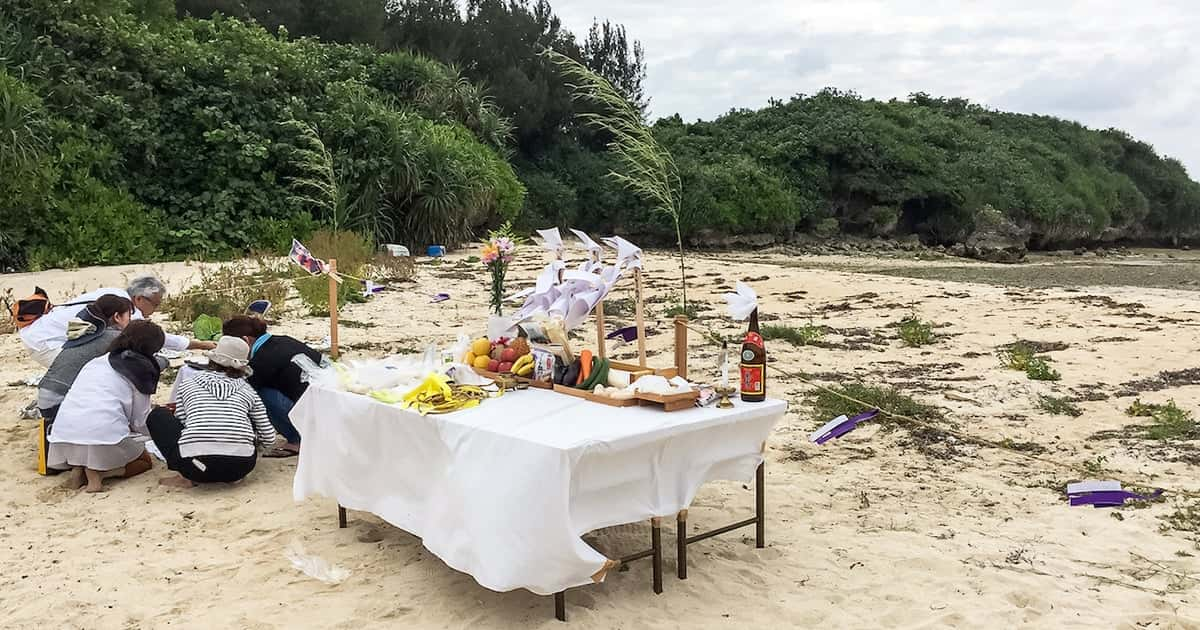
目次
What is Miyako Island’s INORIE 555?
The Beginning of the INORIE Prayer Group
In Japan, freedom of religion is highly valued as people in various parts of the country practice many diverse religions. The Ryukyu Islands in particular is a very spiritual region with many ancient rituals and customs that have been preserved for generations are still being practiced to this day. On the outskirts of Sunayama Beach on Miyako Island at the southern tip of the Ryukyu Islands, the INORIE 555 devotional group met in a rare event that occurred on May 27, 2017. Since world peace is the desire of mankind, the group chose “World Peace, Harmony on Earth, and Harmony in the Universe” to be the theme of this prayer meeting. All of the INORIE participants united their hearts and offered prayers for families, communities, nations, and peace on earth.
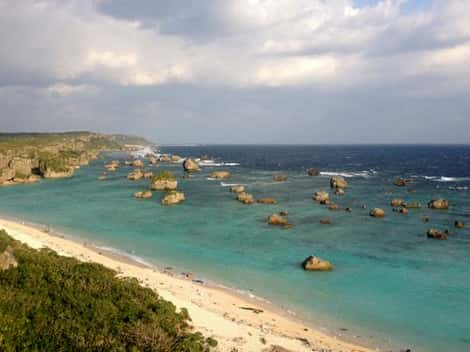
The emerald blue waters of Miyako IslandNaturally, attention was focused on the names of the ritualist and the grand priest who led this event. INORIE 555was the beginning of a new and unprecedented experiment. First, Tsuruko Nema, a renowned oracle from Miyako Island, led the prayers for the INORIE gathering. On Miyako Island, female oracles who have undergone spirit possessions and have had other supernatural experiences are called kankakariya. Since ancient times, these women have played the role of advisors to the local residents. Ms. Nema is rumored to be the last of these kankakariya on Miyako Island.
The Collaboration between the Woman Psychic from Miyako Island and a Priest from Yoshino Kinpusenji Temple!

Kinpusenji Niomon Gate (Japanese National Treasure) The priests from Kinpusenji Temple on Yoshino Mountain agreed to lead this prayer meeting and promised to take part in the “Sacred Sites and Pilgrimage Routes in the Kii Mountain Range”, which was designated as a World Heritage site. Several years ago, Ms. Nema became ill and was hospitalized. She happened to meet the head priest of Kinpusenji Temple by chance. Through this meeting, she was invited to INORIE as a grand master to not only perform the blessing but also lead the gomagi ceremony.
Priests from Kinpusenji Temple in Yoshino, Nara Prefecture then came out to Miyako Island in addition to their travels throughout Japan. News of this unprecedented collaboration quickly spread among the spiritualists who loved Miyako Island, and many were expecting great things from this prayer meeting. Many people who agreed with the purpose of INORE expressed their interests in participating and gathered from all over the country.
The theme of the INORIE prayer is “The Holy Trinity.”
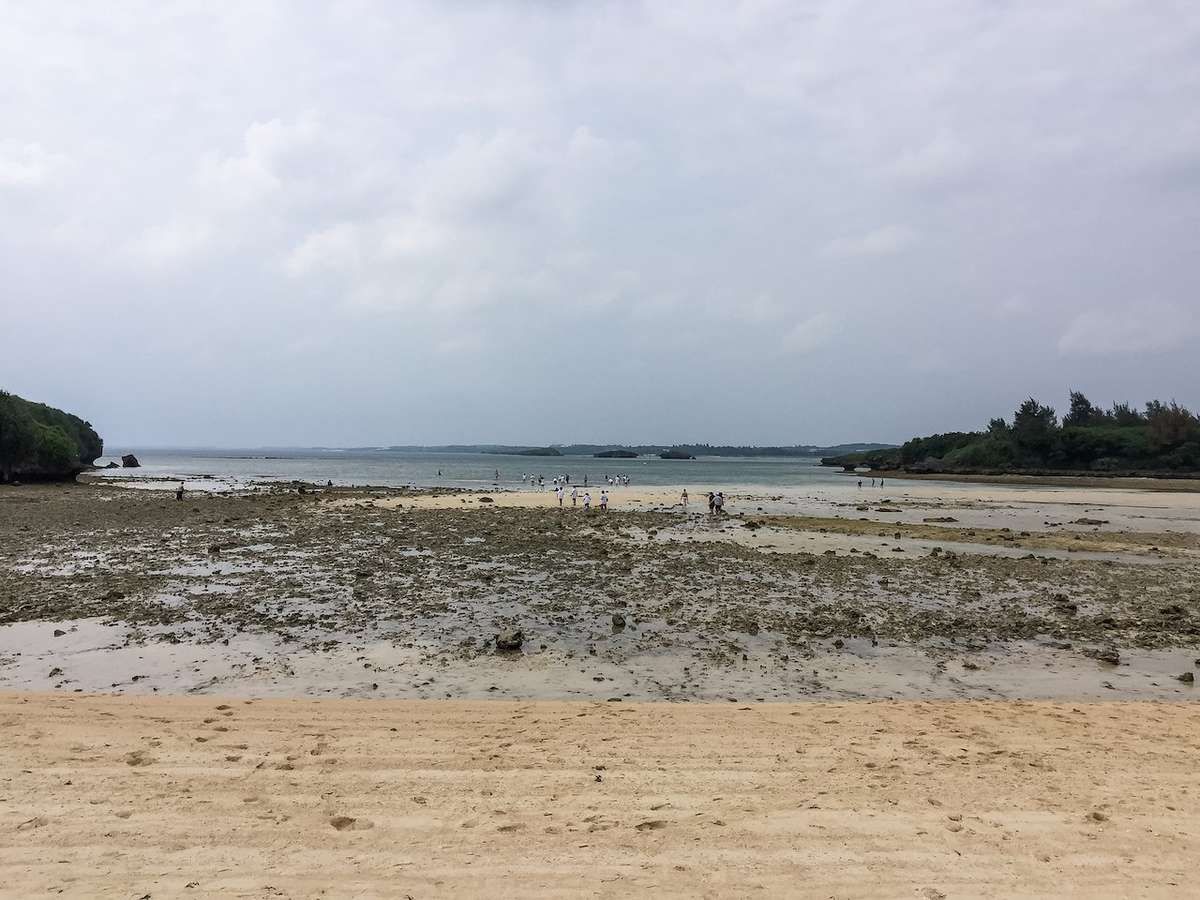
Miyakojima beach where the INORIE meeting was heldINORIE 555 came to be out of the basic need for the participants wanting to practice their faith and devotion to God, Buddha, or both. Therefore, it was important for all people to pray in unison, regardless of whether they were devoted to Shintoism, Buddhism, Shugendo, or any other spiritual path. Moreover, the participants hoped that by praying on such a sacred place like Miyako Island, their prayers would reach the heavens. At the place of prayer, Ms. Nema, who had led the prayer, testified in front of many people that she had received the word “Trinity” from heaven in advance, and everyone prayed with that word in mind.
Ms. Nema has mastered spirituality and the priest who devoted himself to Shugendo in Yoshino, Nara, must have had to overcome many hurdles in order to hold this sacred meeting for prayer and purification together on Miyako Island. Luckily, thanks to the cooperation from its many supporters, INORIE 555 had a successful meeting of prayer. As a result, people passionately prayed to the heavens from the shores of Miyakojima.
Ryukyu, Miyako Island’s Religious Culture and Psychics
What are the Ryukyu Islands?
Once again, let’s take a look at how the Ryukyu and Miyako Island may have been influenced by female oracles long ago. In Ancient China, the islands east of the mainland including Taiwan were called “Ryukyu”. Today, the islands in the south of the Okinawa Islands are called Ryukyu along with Okinawa itself. Among the Ryukyu Islands, Miyakojima is located about 300 km southwest of Okinawa Island. Miyako Archipelago consists of eight islands which includes Tarama Island which is 60km west of Miyakojima and the Yaeyama Islands, which are west of the Miyako Archipelago closer to Yonaguni Island near Taiwan, and at times include the Senkaku Islands, which are also known as the Sakishima Islands.
Prayer site on the Ryukyu Islands (Utaki)
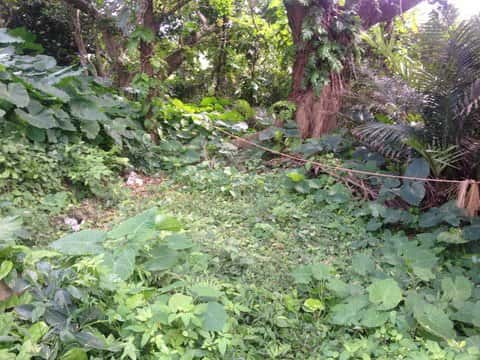
The religious site Nuzuma Utaki on Miyako Island survived an ancient tsunamiRyukyu is known in Japan as a region where ancient indigenous religions have been strongly rooted. The religion that was started on the Ryukyu Islands is sometimes referred to as Ryukyu Shinto since it’s closely connected to the culture and life of the region itself. Since ancient times, places of prayer called “utaki” have been established throughout the islands. There are many utaki that are still carefully protected to this day. By simply visiting these sacred sites where many have prayed and conducted religious ceremonies, one can catch a glimpse into the spirituality of the people from Ryukyu.
Miyako Island’s strong traditional religious culture.

Okanzaki IwakuraTraveling through the Sakishima Islands from Yonaguni Island to the west and Miyako Island to the east, religious elements can be seen in daily lives of the local people. On Yonaguni Island, horses roam free in tranquil pastures so there is little opportunity to see the presence of indigenous religions. However, heading east to Ishigaki Island, one can find Ogamizaki rock and the presence of religion everywhere on the island. Then, heading further east across the sea from Ishigaki Island is Miyako Island. It is no exaggeration to say that traditional religions reached their zenith there, and the most deeply rooted religion of all the Ryukyu Islands has thrived there since ancient times.
For example, at least 230 sacred sites alone were at one time covering an area of approximately 200 km² were recently identified on Miyako Island. These sites include Utaki, Izumi (gaur), and Ryugu (Seaside entrance). In other words, there was a sacred site every 1km² on Miyako Island. Today, there are only about 40 known sacred sites like the Utaki site stretching across the Miyako Archipelago (excluding Miyakojima). This shows how deeply people back then were connected to these indigenous prayer sites like Utaki on Miyakojima.
Women psychics offered prayers at this type of sacred stone site
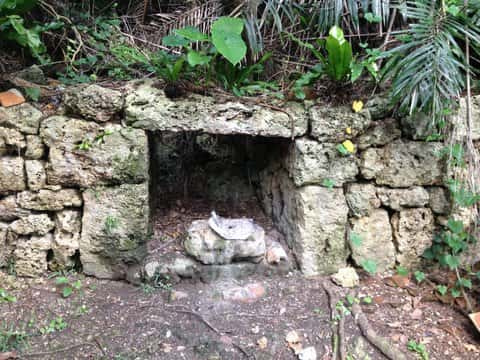
Miyakojima Kisama Utaki, where
the god of Urashima is enshrinedWomen who prayed at these sanctuaries were called “kaminchu” or “shinyo”on Miyako Island and “noro” (shukujo) on the main island of Okinawa. These women were chosen from among the local women and residents. Kaminchu were also in charge of community rituals and festivals and served as intermediaries between the gods and humans, and rituals were often passed down from generation to generation through these ritualists’ family lineage. Kaminchu are called “tsukasa” in Okinawa and “sasu” in Miyakojima. In addition to the kaminchu who performed local ceremonies, there were also female oracless known as miko on the Ryukyu Islands. Among the deity women, those who are the most highly revered are called “yuzasu”. They were called “yuta” on the main island of Okinawa and “kankakariya” on Miyakojima Island.
The true nature of kaminchu is through imparting messages to the living and by letting the spirit take over the kaminchu’s body. Festivals such as the Karimata Uyagan festival on Miyako Island celebrate the kaminchu becoming one with a deity through possession. Their psychic abilities are cultivated through kami-dari, or divine possession.The kaminchu not only speak and announce unknown divine words and songs, but also see visions, and have other spiritual experiences that happen while they’re being possessed. At a first glance, these stories may seem hard to believe, but numerous prophecies have come to fruition and the experiences and testimonies of ordinary people testified that these stories were not false. The psychics have gained the respect of people on the islands as a result of local people spreading their testimonies through word of mouth.
The Women Kankakariya on Miyako Island
The kankakariya of Miyako Island are essentially shamans and they are mostly women. Most of the kankakariya are elderly women, ranging in age from 65 to 90 years old. Since they usually live in the city, they have a family altar in the home where they give offerings and display paraphernalia used for rituals. These women have become an advocate for the common person in the community, as they live only on a small amount of money that they receive by offering incense for prayers. They also have won the trust of the local people by offering advice to their problems such as curing incurable diseases, problems with children, and business failures.
Some of these kankakariya have been so influential that even judges, local politics, and Shinto priests rely on their guidance. Thus, the kankakariya women have long been popular as messengers of the word of God on Miyako Island.
The souls and deities residing in stones that have long been a part of Ryukyu
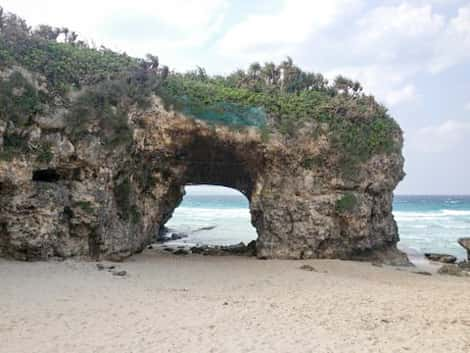
The strange stones on
Sunayama Beach in Miyakojima Island
In Ryukyu, since over a thousand years ago, kankakariya were expected to speak the words, “As Tsuzu instructs, as God says” and make that their mission. The legends and beliefs about the stones have been passed down since ancient times, and it has been believed that people’s souls and deities dwell in the stones. Thus, even today, the stones of the gods can be found in sanctuaries throughout the islands.
These stones or rocks could also be called gods in ancient Israel. In Hebrew, “tsu” means “stone” and is sometimes considered a deity. Thus, “tsuzu” means “god”. Since many people who came from Israel in the distant past are thought to have visited the Japanese archipelago via Ryukyu, the term “tsuzu guidance” that has been passed down in Ryukyu must have meant “the teachings of the gods”. It was the duty and privilege of kankakariya to teach people in the way the gods told them.
Ritual Activities without Successors
However, the aging of the population and the declining birthrate have also hit the Ryukyu Islands, and now all the kankakariya and the uta who practiced their village rituals are aging. Without successors to learn the ancient ways of their spiritual practices are doomed to come to an end. In many of the Ryukyu Islands, including Miyako Island, ancient sacred sites are forever gone due to the haphazard progress of development. As the reality of the lack of successors taking over the ceremonies becomes clearer, many people have become aware that the spiritual culture of Miyako and the Ryukyu Islands is in danger of disappearing.
The ancient shamanic culture that is only found in Ryukyu and Miyako Island occupies an important position as being the roots of Japanese cultural heritage. Spiritual leader Ms. Nema continues to pray for peace as well as for the protection of the sanctuary and for the continuance of the cultural practice of prayer. It is her belief that if she doesn’t pray, there will be no world peace and no future for Japan or Miyako Island. So many people agree with the purpose of INORIE, so much so that Shugendo practitioners of Kinpusan-ji even came to this prayer meeting and opened up their hearts to everyone who attended.
Kankakakarya Nema Tsuruko
Background on Tsuruko Nema, shaman
It is said that Ms. Tsuruko Nema, who served as the leader of this ceremony experienced a violent spirit possession in 1971 when she was a miko (a priestess of superior faith), and over the next five years, overcame severe trials and was reborn into a kankakariya. Born into a very poor family, Ms. Nema suffered from childhood illnesses, anorexia, insomnia, and severe pain. But one day, with the guidance of an oracle, she regained her health through divine intervention from the deity Dhari so that she could use her abilities to help the world. Through the suffering and training she received while she was in solitude, Ms. Nema was able to overcome spiritual problems related to her family and continues to practice spiritual services for her community to this day.
The Incident that Made Tsuruko Nema Famous
The incident that made Tsuruko Nema famous occurred in 1971. At that time, the forests on the island of Miyako had been cut down to the ground in a short period of time due to resort development that began immediately after the US returned the island to Japan. Consequently,the island’s greenery was reduced to half its original size and numerous sacred sites such as Utaki and Gah were also destroyed. Just as the oracle womenKankakariya, Tsukasa, and Yuzasu began to raise their voices in lamentation over this terrible reality, the Nema clan intervened. Perhaps they retaliated in order to protect their island of gods on Miyako Island?
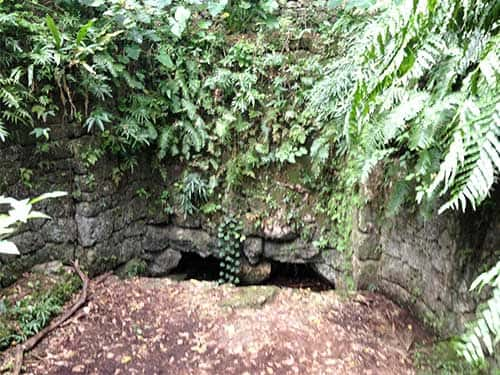
Miyakojima Yamatoya Yamatoga
One day, Ms.Nema became possessed by the god Dhari who kept shouting in a half-crazed manner, “Dig it up, dig it up!” at the Gah well spring that was claimed by construction. She loudly warned the construction workers that if they did not stop the construction of the parking lot, they would cause a tsunami and a famine. Lo and behold, no rain fell on Miyako Island for three months in 1971, which resulted in a severe water shortage and the city of Miyako was forced to abandon construction. It was this incident that immediately propelled Nema’s name into the public.
Tsuruko Nema’s Dedication to Japan and World Peace
Today, Tsuruko Nema fears that the existence of the island’s guardian deity has been endangered by years of reckless development of the island, and that the Japanese nation itself is in danger. For this reason, she continues to call for the protection of the island’s natural environment and calls for the revival of the spiritual practices that respect the gods by taking care of the sanctuaries that still exist.
Upon entering the living room of Tsuruko Nema’s home, one can see the Shinto altar and the hanging scroll behind it with the names of the three deities – Yahatano-kami, Amaterasu-okami, and Kasugano-okami written in large letters. Ms. Nema believes in the reincarnation of the soul and knows through her own experiences that spirits work through the connection between the veil of the heavenly and earthly realms, which is why she makes it a point to honor the spirits of her ancestors with great care. Her belief is that she was born into this lifetime to accomplish what her ancestors had left undone or failed to accomplish. Ms. Nema continues to do her best to help others, the nation, and bring world peace during her lifetime.

A large number of people attended the INORIE meetingAt a first glance, she may appear to be the guru of a new religious cult, but in fact she is not at all like that. An important thing to note is that Tsuruko Nema lives her life in a way that shows no desire for money, power, or status. She still lives quietly in her old house in a corner of Miyako City, leading a simple life that may appear to be impoverished. Because she has overcome the temptation of money and power, and has been faithful in delivering divinely guided messages and never her faith as a tool for profit gain, Ms. Nema has been able to accomplish her mission as a Kankakariya who can overcome the forces of evil and bring happiness to her people. Ms. Nema has said there is still much left to be done of her mission on earth, and even in her old age, she will continue to be active for the sake of Miyako Island, Japan and the world.
What is Shugendo at Kinpusen-ji Temple?
Kinpusenji Temple, the Mecca of Shugendo
The abbot of Kinpusenji Temple, also known as the mecca of Shugendo, joined the INORIE devotional gathering from Yoshino, Nara Prefecture, to pray on Miyako Island in unity with Tsuruko Nema of Kankakarirya. The area of Yoshino where Kinpusenji Temple was built is a part of the “Sacred Sites and Pilgrimage Routes on the Kii Mountain Range,” was designated as a World Heritage Site, and is a prominent temple visited by many. Let’s take a look at the historical background of Kinpusenji Temple and learn about its influence and wonderful spiritual ideologies.
The beautiful mountainous region known as Yoshino stretches to the south of Nara Prefecture. In ancient times, it was part of the Yamato Province, and the mountains from Yoshino to Omine are also called Kinpusan. Omine, including Sanjo-ga-dake, is also called Okuyoshino, and has long provided a place for Shugendo practitioners to train their souls due to the existence of steep mountain paths leading to Kumano. Thus, Mt. Kinpusan came to be known as the “Golden Mitake” (mountain). Kinpusenji Temple was built at the center of Mt. Kinpusenji and it was named a World Heritage Site that occupies an unshakable position as the symbol of Yoshino and as the fundamental training center of Shugendo.
History of Kinpusenji Temple
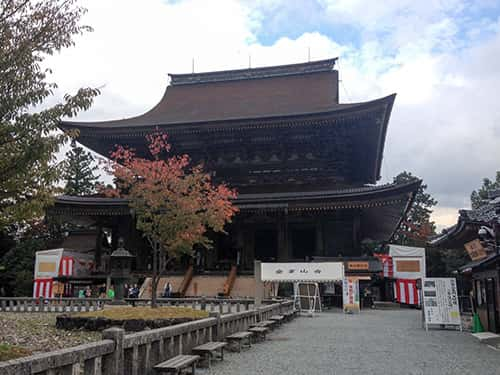
Kinpusenji Zao-doThe history of Kinpusenji dates back more than 1,300 years to the late 7th century when Enno Gyoja trained on Yoshino Mountain and built Kinpusenji Temple. Today, the main hall and Zao Hall on the temple grounds were reconstructed at the end of the 16th century, and many statues, including the hidden statue of Zao Gongen, are enshrined in the hall. Shugendo, or the way of asceticism, is a way of acquiring spiritual power through strictly denying themselves of earthly pleasures through training at Kinpusenji Temple, the head temple of the Shugendo sect. Shugendo, which incorporates many elements of Shintoism and Buddhism into ancient practice of praying on the mountain, is a practical way of purifying and disciplining the body and mind in the great outdoors. Shugendo practitioners seek to follow the teachings of Ennogyojya and attain enlightenment. It should be noted that Shugendo is based on the principle of laymanship. Shugendo teaches that one does not have to be ordained into the priesthood in order to lead a spiritual life, but one should maintain a life of simplicity while improving oneself through practicing the path of Shugendo.
Kinpusenji’s Gomaku Prayers
It goes without saying that prayer is an important part of Shugendo at Kinpusenji Temple. Without prayer, there is no path to spiritual awakening, and spirituality cannot increase. Gomaku, is also performed in which a platform is set up at the place where the Gohonzon or god is to descend, and a fire is lit to pray for the descent of the deity.
The original word “goma” means “to burn things” in Sanskrit, and is said to have its roots in esoteric Persian Buddhism. During the gomaku prayer at Kinpusenji, people write their wishes on gomagi and burn them, praying that they will be fulfilled by the flames of the gomaku, a symbol of the wisdom of the deity. The goma is burned day after day, night after night, and the area around the altar is heated to the point of burns during the ascetic practices of daily life.
The Roots of Yamabushi, Ascetic Practitioners of Shugendo
Shugendo ascetics are called yamabushi. They wear a black, round, lancet-shaped headgear called a tokin on their heads. It is said to be a sign that they can become one with Dainichi Nyorai. Yamabushi are also famous for blowing into conch shells.
The roots of yamabushi most likely originated in ancient Israel. During prayer, ancient Israelite priests dressed in white robes like the mountain priests and wore a small black box on their heads with the word of God written on it, called a hirakriti. They blew into a shofar, which is a sheep horn. Their appearance looks exactly the same as that of a mountain priest wearing a helm hood and blowing a shofar.
According to the Old Testament, the place where people met God was on a tall mountain top, and it was common practice for the Israelites to climb a mountain to meet with God. Perhaps,this ancient Israelite custom and belief has been passed down by the mountain priests and has been carefully preserved to this day.
Kinpusenji Temple and INORIE 555 share the importance of prayer
The Kinpusenji Buddhist temple is dedicated to the harmony between Shintoism and Buddhism. Kinpusenji Temple is also the 26th temple that’s a part of the Nara Shinto-Buddhist Sacred Sites Association, and is also part of the Ennogyoja Sacred Sites Association, and the Yamato Shishin Meguri pilgrimage route, which attracts countless visitors every day. Those who study Shugendo also visit other pilgrimage sites and travel throughout Japan to spend time in the mountains for training and studying. These people work to develop their spirituality.
Considering this background of Shugendo, it was truly a miraculous collaboration for the team of priests to lead the goma offering, the essence of Kinpusenji Temple, which symbolizes Shugendo, at the INORIE devotional gathering on Miyako Island where a Kankakariya led the rituals. The moment when so many people gathered at the sacred place on Miyako, Shugendo practitioners offered their prayers along with those of Ms. Nema Tsuruko. They were able to worship God together and become the embodiment of the peace that everyone had been hoping for.
Experiences of “Miyakojima INORIE 555”
Now it’s time to go to the holy ground of INORIE!
The day of the INORIE prayer meeting took place on May 27,2017. I took an early morning flight from Haneda at 6:40 a.m. via a 3 hour direct flight to Miyako Island The organizers told me in advance that there would be about 60 participants, and I was very excited because they were trying to do something new which no one had ever done before.
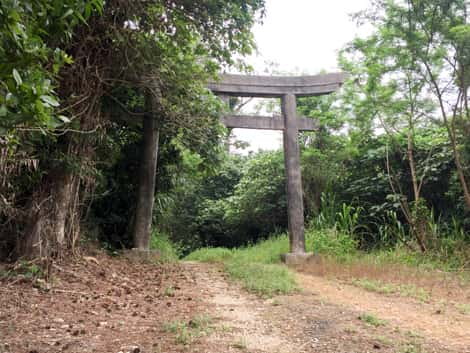
The torii gate entrance gate to the Miyako Island sanctuaryWhen I arrived at the Sunayama Beach parking lot at around 1:20 p.m., there were already many participants wearing white T-shirts with INORIE printed on them, just waiting for Ms. Nema and her group to arrive. My heart was filled to the brim with joy at the thought of taking part in this prayer meeting with these wonderful people at this holy place that was directly connected to the heavens. We were all looking forward to praying for world peace, peace in Japan, and even harmony in the universe.
I heard that apparently most of the participants came from outside the prefecture for this major event. At 1:30 pm, Ms. Tsuruko Nema arrived in a passenger car with the organizers of the event to the meeting place. From there, all of us then drove together to a small forest-like area surrounded by trees near the path where we saw the large torii gate. Dozens of cars were parked in a line along the narrow road, and from that point we walked to the first place of prayer.
Miyako Island INORIE 555, Burning the Goma
After walking about 100 meters, an altar had already been built in the shade of the secluded forest, and the chief priest of Kinpusenji Temple started to lead us in prayer. The name of the place is not certain, but the locals sometimes call it Pazakanmi. The remote areas of the island Miyako are no exception to Japan’s declining birthrate, aging population, and depopulation. Unfortunately, not only the names of places but also the ancient customs, traditions, and religious ceremonies of the island are being lost rapidly. The challenge for the future is how to continue to carefully protect ancient sacred sites like Pazakanmi. I felt that there was nothing else I could do but to pray for peace and the preservation of Miyako Island. There is a challenge waiting ahead of us, and through our prayers, we could possibly preserve this holy island.
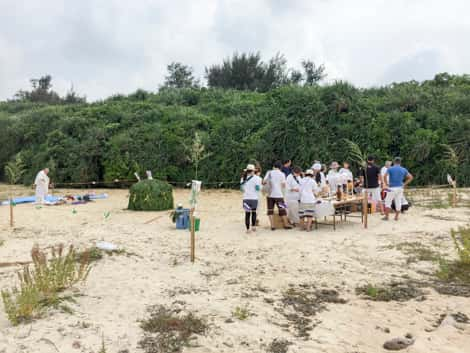
A goma sanctuary spot Miyakojima surrounded by Shimenawa sacred ropeThe prayer ceremony was over in about 30 minutes, and we were once again driven in a group to a nearby shore called Koorabama. I remember walking along this beach without knowing anything about it during my first visit to Miyako Island, and I wondered why I had come back to the same place again. I parked my car in the parking lot and walked down a narrow path to cross the river, where I soon came to see the sandy beach. In a corner of the beach, preparations had already been completed for a goma ceremony to be held by Shugendo practitioners from Kinpusenji Temple.
In ancient times, goma ceremonies in Shingon Shugendo were also called “Saito Ogomaku,” because the platform was built with firewood and firewood. This traditional ceremony is now held on the beach of Miyako Island. Since the goma ceremony was held outdoors on the beach, shimenawa (sacred ropes) were strung around the four sides of the place where the altar was built, each side of which was a little over 10 meters long. This was the time when the koorabama of Miyako Island were fully blessed and bounded. In the center in front of the altar, a 1-meter square and 1-meter high platform was constructed, and the Koorabama were placed one on top of another and covered and decorated with blue leaves along with the framework of the platform.
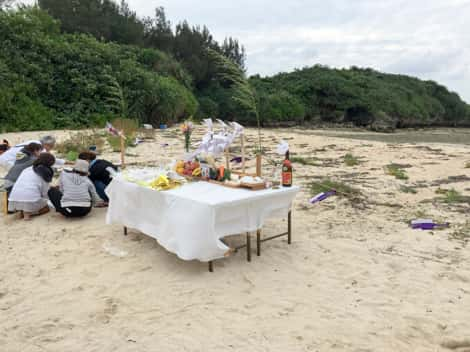 Altar offerings made on the shore of Miyako Island
Altar offerings made on the shore of Miyako Island
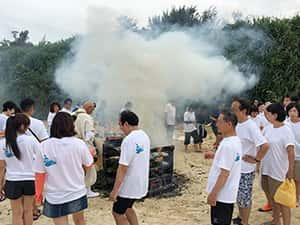 Worshippers walk around the Miyakojima Shibaton Gomadan
Worshippers walk around the Miyakojima Shibaton Gomadan
After the four sides of the dojo were purified, a group of yamabushi (mountain priests) announced themselves loudly with their conch shells and repeatedly chanted questions and answers as they cut the sacred rope and entered the sanctuary in formation from the rear. The chief priest then sat down on the altar and Yamabushi led the ceremony by swinging the lamp that was releasing smoke from the green bush and old wood, and white smoke immediately began to burn at once from the bush burning in the lantern gomadan. Immediately, a loud recitation of the Heart Sutra began, and the echoes of Yamabushi’s voice echoed like angry roars, and some of the participants joined in the recitation. The area was enveloped in a tumultuous atmosphere with the flames soaring high.
Hearing Yamabushi’s prayer of Heart Sutra and seeing the smoke billowing from the goma were accompanied by Tsuruko Nema, who continued to pray in front of the altar, not moving an inch. The meeting was planned with the idea of the Trinity and the fusion of God and Buddha in mind, and it was a time when this idea truly bared fruit. Those who believe in God, those who believe in Buddha, and those who attended the meeting all prayed as one with smoke rising from the Koorabama on Miyako Island. I was filled with gratitude for this time of peace as I felt all of our prayers reaching to the heavens.
